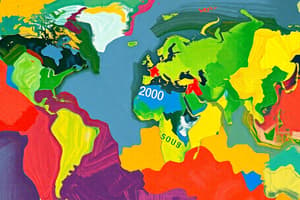Podcast
Questions and Answers
What does the current account in the balance of payments record?
What does the current account in the balance of payments record?
- Transactions in financial assets like FDI and portfolio investment
- Transactions in goods, services, income, and current transfers (correct)
- Transactions in foreign exchange rates and exchange rate regimes
- Transactions in capital flows only
In the balance of payments, a positive current account balance indicates:
In the balance of payments, a positive current account balance indicates:
- More exports than imports (correct)
- Increase in foreign direct investment (FDI)
- Increase in capital flows
- More imports than exports
What type of transactions does the capital account in the balance of payments record?
What type of transactions does the capital account in the balance of payments record?
- Foreign exchange rates determinations
- Income and current transfers
- Transactions in goods and services
- Financial assets like FDI, portfolio investment, and financial derivatives (correct)
Why is the capital account balance often zero in the balance of payments?
Why is the capital account balance often zero in the balance of payments?
What is the main purpose of a country's foreign exchange rate determination?
What is the main purpose of a country's foreign exchange rate determination?
Which of the following is true about exchange rate regimes?
Which of the following is true about exchange rate regimes?
What does the current account typically include?
What does the current account typically include?
Which factor can lead to a decrease in the value of a currency?
Which factor can lead to a decrease in the value of a currency?
What is the capital account primarily concerned with?
What is the capital account primarily concerned with?
Which exchange rate regime allows a country's currency to fluctuate freely based on market forces?
Which exchange rate regime allows a country's currency to fluctuate freely based on market forces?
What can a surplus in the current account indicate about an economy?
What can a surplus in the current account indicate about an economy?
Which factor can positively influence a country's currency value?
Which factor can positively influence a country's currency value?
Flashcards are hidden until you start studying
Study Notes
Navigating the World of International Finance
International finance encompasses the flows of money, goods, services, and capital between countries, shaping global economies and shaping our interconnected world. To better understand this complex and dynamic field, we'll delve into the structure of the balance of payments, its components, and the crucial aspects of foreign exchange rates determination and exchange rate regimes.
Balance of Payments Structure
The balance of payments (BOP) is an economic accounting statement that provides a summary of a country's financial transactions with the rest of the world. The BOP is divided into two main accounts: the current account and the capital account.
-
Current Account: This account records a country's transactions in goods, services, income, and current transfers. A positive current account balance (or surplus) indicates more exports than imports, while a negative balance (or deficit) indicates more imports than exports.
-
Capital Account: This account records a country's transactions in financial assets, such as foreign direct investment (FDI), portfolio investment, and financial derivatives. The capital account balance is often zero due to the counterbalancing effect of capital flows.
Current Account and Capital Account
-
Current Account: The current account typically includes the trade of goods (exports and imports), services (like tourism and consulting), investment income (interest and dividends), and unilateral transfers (like foreign aid and remittances). A surplus in the current account can indicate a strong exporting economy, while a deficit may signal an over-reliance on imports or a weak exporting sector.
-
Capital Account: The capital account records transactions involving the acquisition and disposal of non-produced, non-financial assets, such as intellectual property (patents and copyrights) and land. The capital account also covers transactions in financial assets like stocks and bonds.
Foreign Exchange Rates Determination
Foreign exchange rates (FX) represent the relative value of one country's currency compared to another. FX rates are determined by the interaction of supply and demand in the foreign exchange market, influenced by several factors:
-
Interest rates: Higher interest rates tend to attract more foreign investment, leading to increased demand for the local currency, thereby increasing its value.
-
Inflation rates: Higher inflation rates can lead to a decrease in the value of a currency, as investors seek safer investments in countries with lower inflation rates.
-
Government policies: A country's fiscal and monetary policies can influence investment, trade, and capital flows, thereby affecting the value of its currency.
-
Economic growth: A stronger economy with higher growth rates may attract more investment, which can boost the value of the local currency.
-
Political stability: Stable political environments tend to attract more foreign investment, which can have a positive effect on a country's currency value.
Exchange Rate Regimes
Countries adopt different exchange rate regimes to manage their economies and currencies:
-
Fixed exchange rate: In this regime, a country fixes its currency's value relative to another currency (usually a major currency like the U.S. dollar) or a basket of currencies.
-
Flexible exchange rate: In this regime, a currency's value fluctuates freely in the foreign exchange market, responding to market forces and supply and demand.
-
Crawling peg: In this intermediate regime, a country allows its currency to appreciate or depreciate against a reference currency at a predetermined rate.
-
Target zone: In this regime, a country sets a band within which its currency's value is allowed to fluctuate against a reference currency.
Understanding these subtopics—balance of payments, current account, capital account, foreign exchange rates determination, and exchange rate regimes—provides a solid foundation for navigating the complex and dynamic world of international finance.
Studying That Suits You
Use AI to generate personalized quizzes and flashcards to suit your learning preferences.




